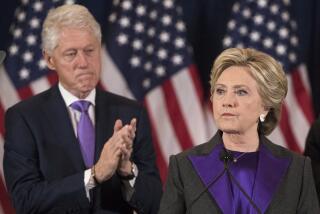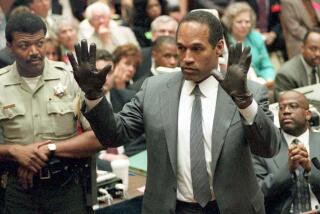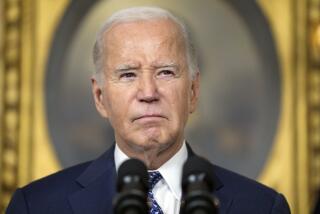Cyberspace’s Coming of Age Bittersweet for Net Faithful
- Share via
The online posting of the independent counsel’s report Friday was widely seen as a defining moment for the Internet, just as the Gulf War was for cable, the Kennedy assassination was for network television, and Edward R. Murrow’s dispatches from World War II London were for radio.
Breaking out of the shadows of its older media siblings, the Internet had the spotlight all to itself for a few hours Friday, as Congress unleashed the lurid details of Kenneth W. Starr’s report on the only medium equipped to convey the lengthy document so instantly and exhaustively.
The posting created a clicking frenzy across the global network, as millions sought a firsthand look at the fruits of an investigation into President Clinton’s sexual relationship with an intern.
But cyberspace’s coming of age was an uncomfortable one for many of its most prominent residents, who rejoiced at the display of the Net’s power and reach, but regretted that it was all centered on such an unseemly episode in the nation’s history.
“This is a defining moment for the Internet, but not necessarily a proud one,” said Esther Dyson, a venture capitalist and Internet guru. “Like it or not, everybody’s going to remember this, and a lot of people are going to say this was the first time they took note of the Internet.”
As much as the posting took advantage of the Net’s strengths, it also exposed some of its weaknesses, and raised anew concerns that have swirled around the Net since it exploded into the mainstream five years ago.
There were philosophical questions about the consequences of the Net’s ascendance, centering on such familiar themes as privacy, censorship, information overload and protections for children.
There were also basic questions about the ability of the sometimes fragile network to handle the spike in traffic. And indeed there were numerous breakdowns, delays and other problems reported.
Seconds after it was posted on the House of Representatives’ Web site and mirrored at dozens of others, millions of people instantly began poring over the report--or at least trying to get pages to load.
“I’ve been trying since late this morning to get to the government sites, but couldn’t access any of them,” said Martin Burack, executive director of the Internet Society in Washington, D.C.
Others had little trouble. “I pulled things up on AOL, getting executive summaries, then later went and got the full text,” said Hugh Siler, a Costa Mesa public relations consultant.
Once they did get the report online, some weren’t sure they wanted to read it and some were simply too tired. Matthew Eichenberger, an assistant at Chapman University’s computer lab in Orange, said he watched as more than a dozen people trolled through the Starr report, but he got through only 15 pages before he became exhausted with the effort.
AT&T; Corp. and Sprint Corp., which operate some of the major pipelines carrying Internet traffic, were reporting usage was up 15% by 3 p.m., and expected to surge even higher later in the day.
The frenzy was expected to last for days, then taper off, as has been the case with other events that prompted Internet logjams, from the Pathfinder mission to Mars to the death of Princess Diana.
But many say the legacy of this event will be more lasting, because it raises unsettling questions about whether direct access to information--as only the Net can provide--is always a good thing.
Many began their day in cyberspace wondering whether the details of the report were appropriate for all eyes. The report contains graphic descriptions of sexual acts, which left many Internet filtering companies and even libraries struggling to tread an uncomfortable line between newsworthiness and salaciousness.
Lycos, a leading search engine on the Net, warned that “some of the contents of this report may be offensive to some people.” The site decided that the report ought to be treated as news, and not be filtered, at least temporarily.
By early morning Friday, the American Library Assn. was flooded with calls from hundreds of librarians across the country, asking whether they ought to make the material available to all patrons or not, said Judith Krug, director of the office for intellectual freedom.
“I told them our responsibility is always to provide ideas and information,” Krug said. “Everyone should have access to this information, which is incredibly important not only for today, but for the future of this republic.”
Critics were quick to point out that the report’s lurid details might well have been banned from the Internet if the Communications Decency Act that was favored by many Republicans hadn’t been overturned in court.
The White House did publish online a response to the report, but it was not circulated nearly as widely as the Starr report.
After the online traffic dissipates, many media experts expect the public to return to radio, newspapers and television for coverage and analysis. Nevertheless, Friday was the most striking example yet of how easy the Net has made it for politicians and other newsmakers to bypass the traditional press.
Cutting journalists out of the process may be welcomed by much of the public, said Jan Schaffer, executive director of the Pew Center for Civic Journalism. But the press has traditionally played an important role in providing balance and context for news events. “Citizens have seen the press spun by Starr and by the White House, and this is an opportunity for them to see the information directly,” she said. “But I don’t think we can say whether that’s a good thing or not.”
Others questioned the usefulness of dumping a 445-page report on a public that is already suffering from information overload.
As speedy publishing becomes easier, time for reflection and restraint may be sacrificed, said Gregory Stock, director of the Science, Technology and Society program at UCLA.
“Everyone has been able to see the report at basically the same moment as the president,” Stock said. “It is like a feeding frenzy.”
Indeed, that was the scene across Orange County and much of the country Friday afternoon.
Rueben Martinez, owner of Martinez Books in Santa Ana, was overwhelmed by the detail after an afternoon of reading and discussing the report with two employees.
“We’re pulling stuff up [from the Internet] and I cannot believe what I’m reading. It tells you where the hands went and what the hands were doing.”
Such detail made some squeamish. UC Irvine student Rodrigo Diaz felt it was like gawking at a bad car wreck on the side of a highway. “It’s human nature,” he said. “The news hasn’t gone in depth and the report is in detail.”
But Brian Park soaked up his time on a Chapman computer to digest the information first-hand. As a member of the conservative Young Americans for Freedom, he’s not in Clinton’s corner, but he thought the President could have won over the people had he acted earlier.
“If he just came clean with the affair, the American people would forgive him,” he said.
Times staff writers Ashley Dunn, Karen Kaplan and John Glionna in Los Angeles; Elaine Gale, Nancy Cleeland and Greg Hernandez in Orange County; Charles Piller in San Francisco; and Jube Shiver Jr. in Washington contributed to this story.
(BEGIN TEXT OF INFOBOX / INFOGRAPHIC)
Navigating the Websites
Internet users will likely encounter delars and/or error messages when trying to access the Starr report and White House rebuttal due to the high volume of visitors to the various Web sites. Here’s a look at what the report looks like on the Web and tips on finding information quickly:
Principal participants, first family, White House personnel, Lewinsky’s friends and family, lawyers and judges.
Investigation background, current status of investigation.
Bulk of the report, with details on the nature of relationship between President Clinton and Monica S. Lewinsky; details on conversations, gifts and sexual contacts; contact and encounters between 1995 and 1997; Lewinsky subpoena; affidavit; deposition.
Evidence that Clinton lied under oath and obstructed justice, including details of phone sex, physical evidence and testimony of Lewinsky’s friends, family and counselors.
****
Tips for Web Users
* Try different sites: The report is posted on a number of Web sites; if unable to get on one, try others.
* Off hours: Avoid the busiest “prime times”; easiest access is probably late night and early morning.
* Find something quickly: To skip parts of the report you don’t want to read, hit Control F when using Windows (Command/Apple F for Macintosh), then type in key words to search for.
****
Where to Find the Report
The 445-page report has been posted through government Web addresses, as well as news organization sites and Internet access providers. Here is a sampling.
http://mediakit.nohib.com/scandal
https://thomas.loc.gov/icreport
https://www.access.gpo.gov/congress/icreport
https://www.house.gov/judiciary
https://www.house.gov/icreport
https://www.starrtext.ap.org
https://www.netscape.com
https://www.yahoo.com
https://www.aol.com
Source: Various Web site s ; Times staff ; Researched by JULIE SHEER / Los Angeles Times






